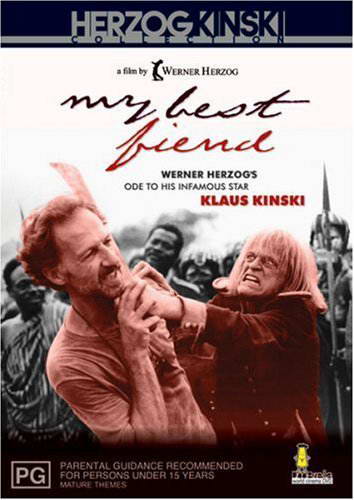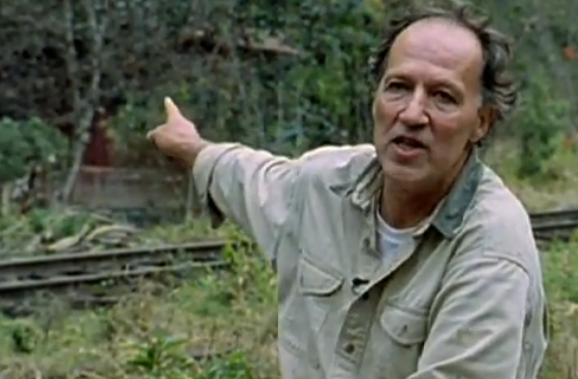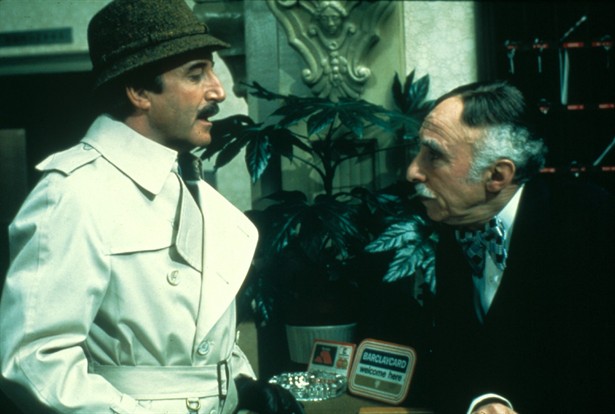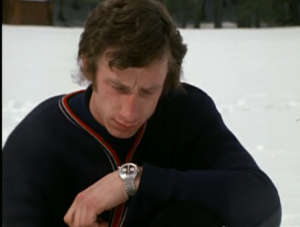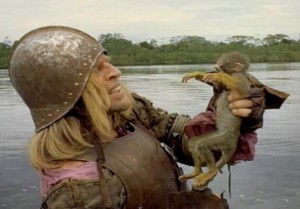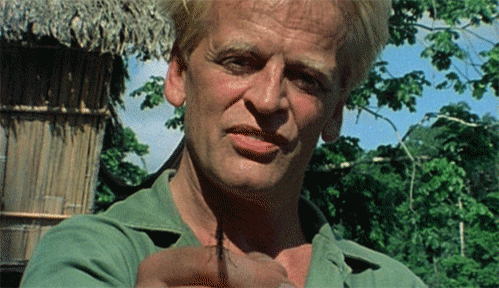From the Chicago Reader (February 11, 2000). — J.R.
My Best Fiend
Rating * Has redeeming facet
Directed and written by Werner Herzog.
What’s the difference between artistry and bravado? This isn’t a question I generally feel inclined to ask, but I’m compelled by the work of Werner Herzog, who scrambles the two until it’s difficult to tell which is which. My Best Fiend — Herzog’s documentary feature about his tumultuous collaborations with Klaus Kinski, the mad actor with whom he made some of his most notable films — also compels questions about Kinski’s bravado and artistry, and suggests that it might not always be easy to distinguish his from Herzog’s.
One might call My Best Fiend, which is playing this week at Facets, the art-movie equivalent of writer-director Blake Edwards’s Trail of the Pink Panther. Edwards and Peter Sellers reportedly were at each other’s throats throughout their many collaborations on Pink Panther comedies — largely, it appears, because of Sellers’s hyperbolically neurotic behavior. Herzog and Kinski had a similarly volatile relationship, which ended only after Kinski died, in 1991. Herzog got his revenge by releasing outtakes of his difficult star, much as Edwards continued to fiddle around with unreleased footage of Sellers as Inspector Clouseau in Trail of the Pink Panther. Herzog offers a personal documentary about Kinski and himself — recollecting particular tantrums and outrages while speculating on their significance, revisiting the Peruvian locations of some of their joint efforts, interviewing former crew members, showing Kinski behaving vilely to everyone around him.
The two men worked on five films together: Aguirre: The Wrath of God (1972), Nosferatu (1978), Woyzeck (1978), Fitzcarraldo (1981), and Cobra Verde (1987). I’ve seen all but the last and have no desire to see the second, third, or fourth again. Even Les Blank’s Burden of Dreams, a documentary feature about the making of Fitzcarraldo, is more fun to watch than Fitzcarraldo, which seemed from the beginning like a pointless remake of Aguirre. Nosferatu is a pointless if dutiful remake of F.W. Murnau’s silent masterpiece — a precedent for Gus Van Sant’s remake of Hitchcock’s Psycho as an act of pious irrelevance. All of the Herzog-Kinski films sound like they were difficult to shoot, on top of Kinski’s being extremely difficult to work with, and one often feels that this is precisely why Herzog made them — as grand, heroic, Faustian gestures rather than as works that people might have good reason to go see. As a result, the production stories are usually much livelier than the movies themselves.
What’s the difference between behaving like an artist and acting like a pompous jerk? My Best Fiend repeatedly raises this question about Kinski, but it tries to avoid raising the same question about Herzog, even though Herzog hired Kinski again and again and clearly knew what he was getting into. One of the first and most important revelations of this documentary is that for three months when he was 13 Herzog lived in the same boardinghouse as Kinski — and thus was fully aware of Kinski’s insane behavior long before they worked on movies together. In certain respects Herzog clearly saw Kinski as his doppelganger, capable of expressing his craziness overtly where Herzog could express his only covertly. And it’s highly likely that Kinski regarded Herzog as his doppelganger. But this sick symbiosis is just about the last thing Herzog seems willing to discuss, and as a consequence he has to resort to repeated denials and disavowals, assuring us that Kinski was the crazy one, not him, and giving us plenty of footage of the actor to prove it.
What’s the difference between artistry and bravado? I ask the question first out of irritation: Herzog may get his fans to confuse his bravado with artistry, but I’m not going to be suckered. Yet I know the issue isn’t that simple, because to distinguish artistry from bravado, one has to face a philosophical conundrum comparable to the one about whether a tree falling in a forest without a witness makes any sound. That is, is artistry — or bravado, for that matter — to be found in the artist, in the eye of the beholder, or in both? And rather than neatly divvy up humanity into artists and charlatans, as convention and mainstream reviewers often encourage us to do, can’t we assume that some artists are also charlatans and vice versa?
“I’ll have to break my skull before they’ll believe me,” declares Walter Steiner, a wood-carver and nearly suicidal ski jumper, the characteristic subject of Herzog’s highly characteristic 1975 documentary The Great Ecstasy of the Woodcarver Steiner. “But probably they won’t listen until I give up.” Herzog later quotes Steiner saying “Fifty thousand people waiting to see me crash.” It seems fundamental to Herzog’s method that “they” in the first statement and “people” in the second don’t in any way implicate the members of the audience, who are left alone just as spectators at a circus sideshow are left alone — invited to gawk in peace without being gawked at. Unlike Tod Browning’s Freaks, which repeatedly confronts the audience with its own morbidity, Herzog’s movies about outcasts, lunatics, and fanatics usually allow the viewer to watch in the dark and from a safe voyeuristic distance — much the way that Herzog speaks about Kinski.
I saw my first Herzog movie, Even Dwarfs Started Small, in 1970, and in spite of the intriguing title, it bored me to distraction. The rationale for making it seemed to follow the carny wisdom that hiring a bunch of dwarfs and midgets was a surefire way to establish your credentials in the avant-garde; figuring out something for the dwarfs and midgets to do was strictly secondary. As dumb as it sounds, Alejandro Jodorowsky successfully launched his own filmmaking career the same year by following a similar tactic in El topo — the main difference being that he had more shocks and conceits up his sleeve; Herzog had hardly any, just a loose notion that the little people should be mean-spirited and cackle a lot.
I much preferred Herzog’s Aguirre: The Wrath of God, which I saw three years later. A meditative period adventure about Spanish conquistadors searching for El Dorado in the wilds of 16th-century Peru, it’s still my favorite Herzog movie, thanks to its poetry and to what it does with compositions involving mountains, rivers, monkeys, and human figures seen from a distance — vertical arrangements that call to mind landscapes such as Brueghel’s The Conversion of Saint Paul. With its delirious circular camera movements and other awed responses to the crazed conquistador incarnated — rather than played — by Kinski, it comes across less as a narrative than a swooning vision that parallels the fanaticism of the hero, a kind of crazed expressionism built around the notion of overreaching.
There were a couple of catches. The English dubbing of the version I saw, complete with Brooklyn accents, was so horrendous that the movie seemed to mutate into some awful Richard Egan opus every time someone opened his or her mouth; as a result the film went undiscovered in the U.S. until a German-language version with subtitles became available a year or so later. The other catch was that the historical basis for this movie — signaled in the opening title, which states, “The only document to survive from this lost expedition is the diary of the monk Gaspar de Carvajal” — turned out to be a fabrication, another carny trick. When someone asked Herzog about the monk’s diary after a screening at Cannes, he explained that he simply made it up to give the movie more credence. About 20 years later, at the San Francisco film festival, he cheerfully admitted that the epigraph attributed to Pascal in Lessons of Darkness, his 1991 documentary about the beauty of burning oil during the gulf war, was invented as well; he said he attached a famous writer’s name to it so that people would treat it more seriously.
What are we to make of such a habit? I’ve been told that Stendhal did the same thing with some of the epigraphs in The Red and the Black, though he, of course, saw himself as an artist in hiding who wrote for future generations. I suspect that Herzog has very different motives for impersonating a great writer, motives that have more to do with the behavior of artists as perceived by the general public and less to do with the functioning of artworks. That’s probably why he has so little to say about himself in My Best Fiend and why he lets Kinski, as usual, rave on interminably.

